Stewart J. College Algebra: Concepts and Contexts
Подождите немного. Документ загружается.


374 CHAPTER 4
■
Logarithmic Functions and Exponential Models
41–48
■ Use a graphing calculator to find all solutions of the equation.
41. 42.
43. 44.
45. 46.
47. 48.
49. Compound Interest Aviel invests $6000 in a high-yield uninsured certificate of
deposit that pays 4.5% interest per year, compounded quarterly.
(a) Find a formula for the amount A of the certificate after t years.
(b) What is the amount after 2 years?
(c) How long will it take for his investment to grow to $8000?
50. Compound Interest Ping invests $4000 in a saving certificate that has an interest
rate of 2.75% per year, compounded semiannually.
(a) Find a formula for the amount A of the certificate after t years.
(b) What is the amount after 4 years?
(c) How long will it take for her investment to grow to $5000?
51. Compound Interest Suzanne is planning to invest $2000 in a certificate of deposit.
How long does it take for the investment to grow to $3000 under the given conditions?
(a) The certificate of deposit pays interest annually, compounded every month.
(b) The certificate of deposit pays interest annually, compounded continuously.
52. Compound Interest Masako is planning to invest $5000 in a certificate of deposit.
How long does it take for the investment to grow to $8000 under the given conditions?
(a) The certificate of deposit pays 3.55% interest annually, compounded every month.
(b) The certificate of deposit pays 3.05% interest annually, compounded continuously.
53. Salmonella Bacteria Count Although cooking meat kills the microorganisms in it,
they may survive gentle frying and roasting, especially if the meat was not properly
defrosted before preparation. Inspectors for the U.S. Department of Agriculture test for
Salmonella in a sample of chicken at a meat-packing plant. The sample is found to have
a bacteria count of 15 colony-forming units per milliliter (CFU/mL). The sample is kept
at a temperature of , and 6 hours later the count is 20,000 CFU/mL.
(a) Find the instantaneous growth rate r for the bacteria count in the sample.
(b) Find an exponential model for the bacteria count in the sample, where t
is measured in hours.
(c) What does the model predict the bacteria count will be after 4 hours?
(d) How long will it take for the bacteria count to reach 10 million CFU/mL?
(e) Find the doubling time for the Salmonella bacteria.
54. E. coli Bacteria Count Inspectors for the U.S. Department of Agriculture test a
sample of ground beef for the bacterium E. coli. The sample is found to have a bacteria
count of 100 colony-forming units per milliliter (CFU/mL). The sample is kept at a
temperature of , and 2 hours later the meat has a count of 13,300 CFU/mL.
(a) Find the instantaneous growth rate r (per hour) for the bacteria count in the sample.
(b) Find an exponential model for the bacteria count in the sample, where t
is measured in hours.
(c) What does the model predict the bacteria count will be after 3 hours?
(d) How long will it take for the bacteria count to reach one million CFU/mL?
(e) Find the doubling time for the population of E. coli bacteria.
55. Population of Ethiopia In 2003 the United Nations estimated that the population of
Ethiopia was about 70.7 million, with an annual growth rate of 2.9%. Assume that this
rate of growth continues.
f 1t 2
= Ce
rt
100°F
f 1t 2= Ce
rt
80°F
2
7
8
%
3
1
2
%
e
x
2
- 2 = x
3
- x4
-x
= 1x
x = ln14 - x
2
2x
3
- x = log1x + 12
2
-x
= x - 1e
x
=-x
log x = x
2
- 2ln x = 3 - x
CONTEXTS
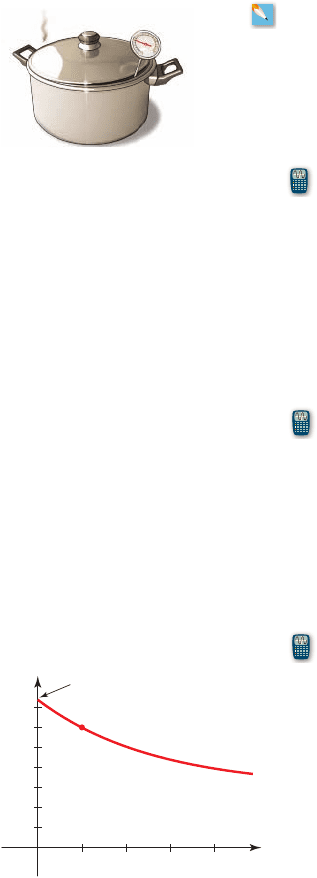
SECTION 4.5
■
Exponential Equations: Getting Information from a Model 375
(a) Find the yearly growth factor a.
(b) Find an exponential growth model for the population t years since 2003.
(c) How long will it take for the population to double?
(d) Use the model found in part (b) to predict the year in which the population will
reach 90 million.
56. Population of Germany In 2004 the population of Germany was about 82.5 million,
with an annual growth rate of 0.02%. Assume that this rate of growth continues.
(a) Find the yearly growth factor a.
(b) Find an exponential growth model for the population t years since 2004.
(c) How long will it take for the population to double?
(d) Use the model found in part (b) to predict the year in which the population will
reach 83 million.
57. Pot of Chili Angela prepares a large pot of chili the night before a church potluck.
The temperature of the chili is , and it must cool down to before it can be
stored in the refrigerator. Assume that the ambient temperature is and the heat
transfer coefficient is .
(a) Find a model for the temperature T of the pot of chili t hours after cooling.
(b) How long will it take for the pot of chili to cool down to the desired temperature of
?
(c) Graph the function T to confirm your answers to parts (a) and (b).
58. Time of Death Newton’s Law of Cooling is used in homicide investigations to
determine the time of death. Suppose that a body is discovered in a location whose
ambient temperature is . The police determine that the heat transfer coefficient in
this case is . (The heat transfer coefficient depends on many factors,
including the size of the body and the amount of clothing.) Normal body temperature is
.
(a) Find a model for the temperature T of the body t hours after death.
(b) When the body was found, it had a temperature of . Find the length of time the
victim has been dead.
(c) Graph the function T to confirm your answers to parts (a) and (b).
59. Boiling Water A kettle of water is brought to a boil in a room where the temperature
is . After 15 minutes the temperature of the water has decreased from to
.
(a) Find the heat transfer coefficient k, and find a model for the temperature T of the
water t hours after it is brought to a boil.
(b) Use the model to predict the temperature of the water after 25 minutes. Illustrate by
graphing the temperature function.
(c) How long will it take the water to cool to ?
(d) Graph the function T to confirm your answers to parts (b) and (c).
60. Cooling Turkey A roasted turkey is taken from an oven when its temperature has
reached and is placed on a table in a room where the temperature is . The
graph shows the temperature of the turkey after x hours.
(a) Find a model for the temperature T of the turkey t hours after it is taken out of the
oven.
(b)
Use the model to predict the temperature of the turkey after 45 minutes.
(c) How long will it take the turkey to cool to ?
61. Radioactive Radium The half-life of radium-226 is 1600 years. Suppose we have a
22-mg sample.
(a) Find the yearly growth factor a.
(b) Find an exponential model for the mass remaining after t years.m1t 2= Ca
t
100°F
75°F185°F
40°C
75°C
100°C20°C
72°F
98.6°F
k = 0.1947
60°F
70°F
k = 2.895
65°F
70°F212°F
f 1t 2= Ca
t
f 1t 2= Ca
t
x
T
50
100
150
185
(0.5, 150)
12
0
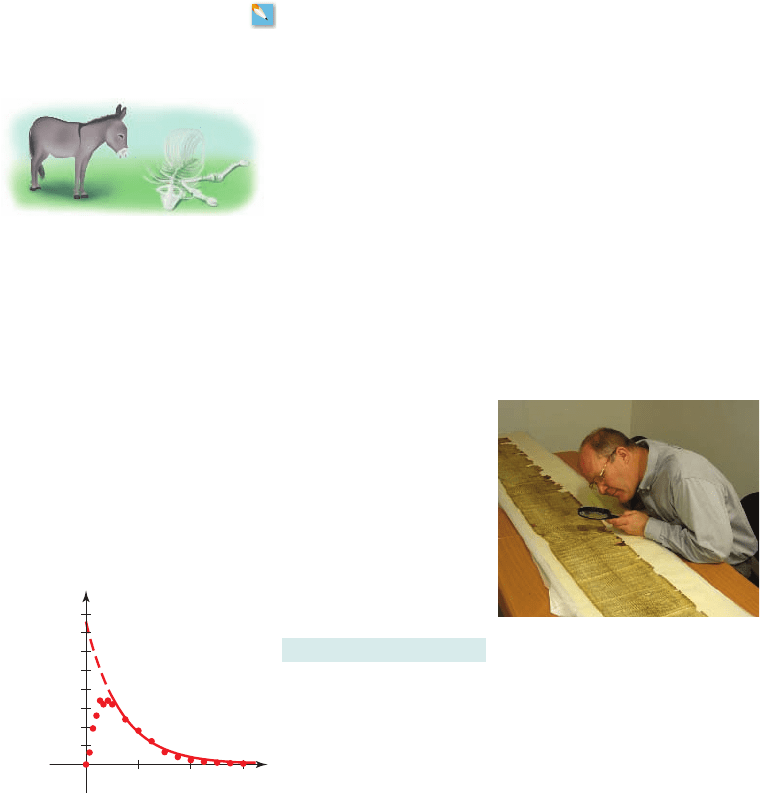
376 CHAPTER 4
■
Logarithmic Functions and Exponential Models
(c) How much of the sample will remain after 4000 years?
(d) After how long will only 18 mg of the sample remain?
62. Radioactive Cesium The half-life of cesium-137 is 30 years. Suppose we have a
10-gram sample.
(a) Find the yearly growth factor a.
(b) Find an exponential model for the mass remaining after t years.
(c) How much of the sample will remain after 80 years?
(d) After how long will only 2 mg of the sample remain?
63. Plutonium-239 A nuclear power plant produces radioactive plutonium-239, which
has a half-life of 24,110 years. Because of its long half-life, plutonium-239 must be
disposed of safely. How long does it take 100 grams of radioactive waste from the
nuclear power plant to decay to 10 grams?
64. Strontium-90 One radioactive material that is produced in atomic bombs is the
isotope strontium-90, which has a half-life of 28 years. If a person is exposed to
strontium-90, it can collect in human bone tissue, where it can cause leukemia and other
cancers. If an atomic bomb test site is contaminated by strontium-90, how long will it
take for the radioactive material to decay to 10% of the original amount?
65. Carbon-14 Dating Archeologists find an ancient shard of pottery and use some burnt
olive pits found in the same layer of the site to determine the age of the shard. The
archeologists determine that the olive pits contain 69.32% of the carbon-14 that is present in
a living olive. (The half-life of carbon-14 is 5730 years.) How old is the shard of pottery?
66. Carbon-14 Dating A donkey bone is estimated to contain 73% of the carbon-14
that it contained originally. How old is the donkey bone? (The half-life of carbon-14
is 5730 years.)
67. Dead Sea Scrolls The Dead Sea Scrolls are documents that contain some of the
oldest known texts of parts of the Hebrew bible. They were discovered between 1947
and 1956 in several caves near the ruins of the ancient settlement of Khirbet Qumran on
the northwest shore of the Dead Sea. Archeologists determine that a sample taken from
the scrolls contains 79.10% of the carbon-14 that it originally contained. (The half-life
of carbon-14 is 5730 years.)
(a) Estimate the age of the Dead Sea Scrolls.
(b) Search the Internet for the historical date of the writing of the Dead Sea Scrolls.
How does this date compare with your estimate?
m1t 2= Ca
t
Donald Parry
0.3
0.4
0.2
0.1
y (mg/mL)
L
13
Time (h)
2
0
x
68. Algebra and Alcohol The table in the Prologue (page P2) gives the alcohol
concentration at different times following the consumption of 15 mL of alcohol. A
scatter plot of the data (see the margin) shows that the alcohol concentration reaches a
maximum in about half an hour and then begins to decay exponentially. The function
closely models the decay part of the alcohol concentration. Use this function to
determine the time at which the concentration decays to 0.05 mg/mL.
L1t 2= 0.38e
-1.5t
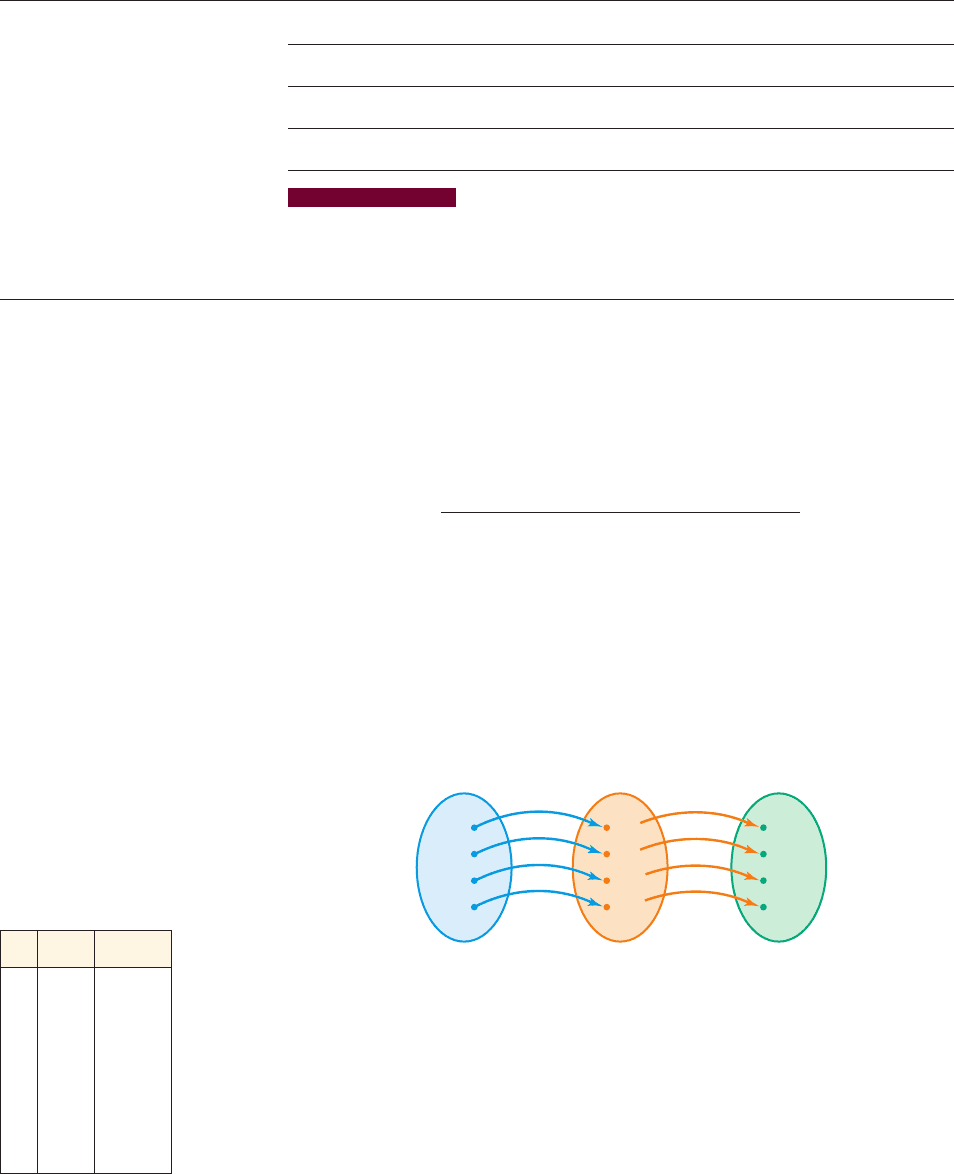
SECTION 4.6
■
Working with Functions: Composition and Inverse 377
2
4.6 Working with Functions: Composition and Inverse
■
Functions of Functions
■
Reversing the Rule of a Function
■
Which Functions Have Inverses?
■
Exponential and Logarithmic Functions as Inverse Functions
IN THIS SECTION… we study a method of combining functions called composition. We
also study inverse functions and see how the logarithm and exponential functions are
inverses of each other.
2
■ Functions of Functions
In many real-world situations we need to apply several functions in a row, that is, the
output of one function is used as the input to the next function. For example, suppose
you work for $8 an hour, and you pay tax at the rate of 5%. The function that gives
your pay for working x hours is , and the function that calculates the tax
on an income of x dollars is .T1x2= 0.05x
P1x 2= 8x
0 h
1 h
2 h
3 h
$0
$8
$16
$24
Pa
y
(dollars)
PT
Work (hours)
$0.00
$0.40
$0.80
$1.20
Tax (dollars)
figure 1 From “hours worked” to “pay received”
to “tax paid”
table 1
x
P1x 2 T1P1x 22
0 0 0
1 8 0.40
2 16 0.80
3 24 1.20
4 32 1.60
5 40 2.00
6 48 2.40
7 56 2.80
Function In Words
P1x 2= 8x
“Pay for working x hours”
T1x 2= 0.05x
“Tax on x dollars”
Let’s say that we want to find how much tax you pay when you work x hours. To do
this, we must apply the functions P and T in the appropriate order. We start with the
input x hours, apply the function P to get the pay, and then apply the function T
to get the tax on that pay. For example, if you work 2 hours, then your pay is
dollars. Then we apply the function T to this output to get
. The diagram in Figure 1 shows how we apply these two
functions.
T116 2= 0.051162= 0.80
P12 2= 8122= 16
What we did was start with an input of x hours, apply the function P to get ,
then apply the function T to the result to get . We can express this as a single
function whose input x is the number of hours worked and whose output is the
tax owed. Several values of are given in Table 1. In general we call the
process of applying one function to the output of another composition of functions.
T1P1x 22
L1x 2
T1P1x 22
P1x 2

378 CHAPTER 4
■
Logarithmic Functions and Exponential Models
example
1
Composing Functions
Find the composition of the tax function with the pay function
.
Solution
We use L as the name of the new composite function. Then
Definition of the new function L
Definition of P
Definition of T
Simplify
So the new function is . You can check that this function gives the val-
ues in Table 1.
■ NOW TRY EXERCISE 15 ■
L1x 2= 0.40x
= 0.40x
= 0.0518x2
= T18x2
L1x 2= T1P1x 22
P1x 2= 8x
T1x 2= 0.05x
example
2
A Function of a Function
Let and . Give a verbal description of each of the following
composite functions, and then find an algebraic expression for the function.
(a)
(b)
Solution
(a) The function first applies the rule f and then applies the rule .
So M is the rule “Square, then add 1.” In symbols we have
Definition of the function M
Definition of f
Definition of g
So
(b) The function first applies the rule and then applies the rule f.
So N is the rule “Add 1, then square.” In symbols we have
g N1x 2= f 1g 1x 22
M1x 2= x
2
+ 1.
= x
2
+ 1
= g1x
2
2
M1x 2= g1f 1x 22
gM1x2= g1f 1x 22
N1x 2= f 1g1x 22
M1x 2= g1f 1x 22
g1x 2= x + 1f 1x2= x
2
Of course, to be able to compose f with , the range of must be contained in
the domain of f. In the next example we find an expression for the composition of
the “Tax” and “Pay” functions described above.
gg
The Composition of Functions
Given two functions f and , we can make a new function h called the
composition of f with , defined by
h1x 2= f 1g1x 22
g
g
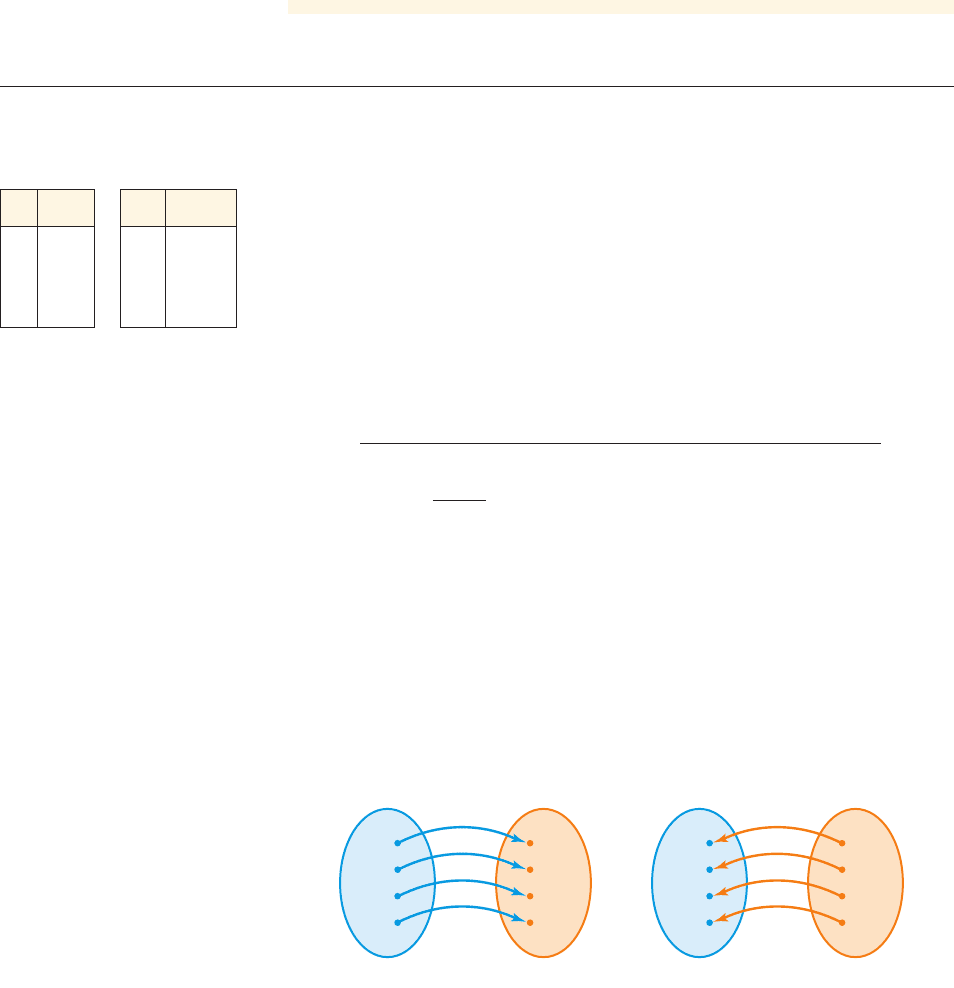
SECTION 4.6
■
Working with Functions: Composition and Inverse 379
2
■ Reversing the Rule of a Function
Definition of the function N
Definition of g
Definition of f
So .
■ NOW TRY EXERCISE 17 ■
N1x 2= 1x + 12
2
= 1x + 12
2
= f 1x + 12
N1x 2= f 1g1x 22
x
P1x 2
0 12
1 14
2 16
3 18
x
P
-1
1x 2
12 0
14 1
16 2
18 3
0
1
2
3
$12
$14
$16
$18
Price
Function P
Toppin
g
s
0
1
2
3
$12
$14
$16
$18
Price
Inverse function P
⫺1
Toppin
g
s
figure 2 The function “reverses” the function P.P
-1
Function In Words
P1x 2= 2x + 12
“Price of a pizza with x toppings”
P
-1
1x 2=
x - 12
2
“Number of toppings of a pizza with price x”
The rule P is “Multiply by 2, then add 12,” and the rule for is “Subtract 12,
then divide by 2.” Do you see how the rule reverses the rule for P? Try starting
with 5 toppings. Apply P to get 22, then apply to 22 to get back to 5.
P 51022
P
⫺1
51022
The diagrams in Figure 2 show the relationship between P and .P
-1
P
-1
P
-1
P
-1
¡
¬
¡
¬
¡
¬
¡
¬
Multiply by 2
Divide by 2
Add 12
Subtract 12
In general, the inverse of a function is defined as follows.
We often need to reverse the rule of a function. In other words, we might want to find
the rule that takes us from the output of a function back to the corresponding input.
For example, suppose that at your local pizzeria the daily special is $12 for a
plain cheese pizza plus $2 for each additional topping. We can express the price of
the pizza as a function whose input x is the number of toppings and
whose output is the price. The function that “reverses” the rule of P is the function
whose input is the price and whose output is the number of toppings. You can check
that the rule for getting the number of toppings from the price is “Subtract 12 from
the price, then divide by 2.” This rule “reverses” the rule P; the notation for this
new rule is (read “P inverse”). So is the function . (The
tables in the margin give several values of P and .)P
-1
P
-1
1x 2= 1x - 122>2P
-1
P
-1
P1x 2= 2x + 12
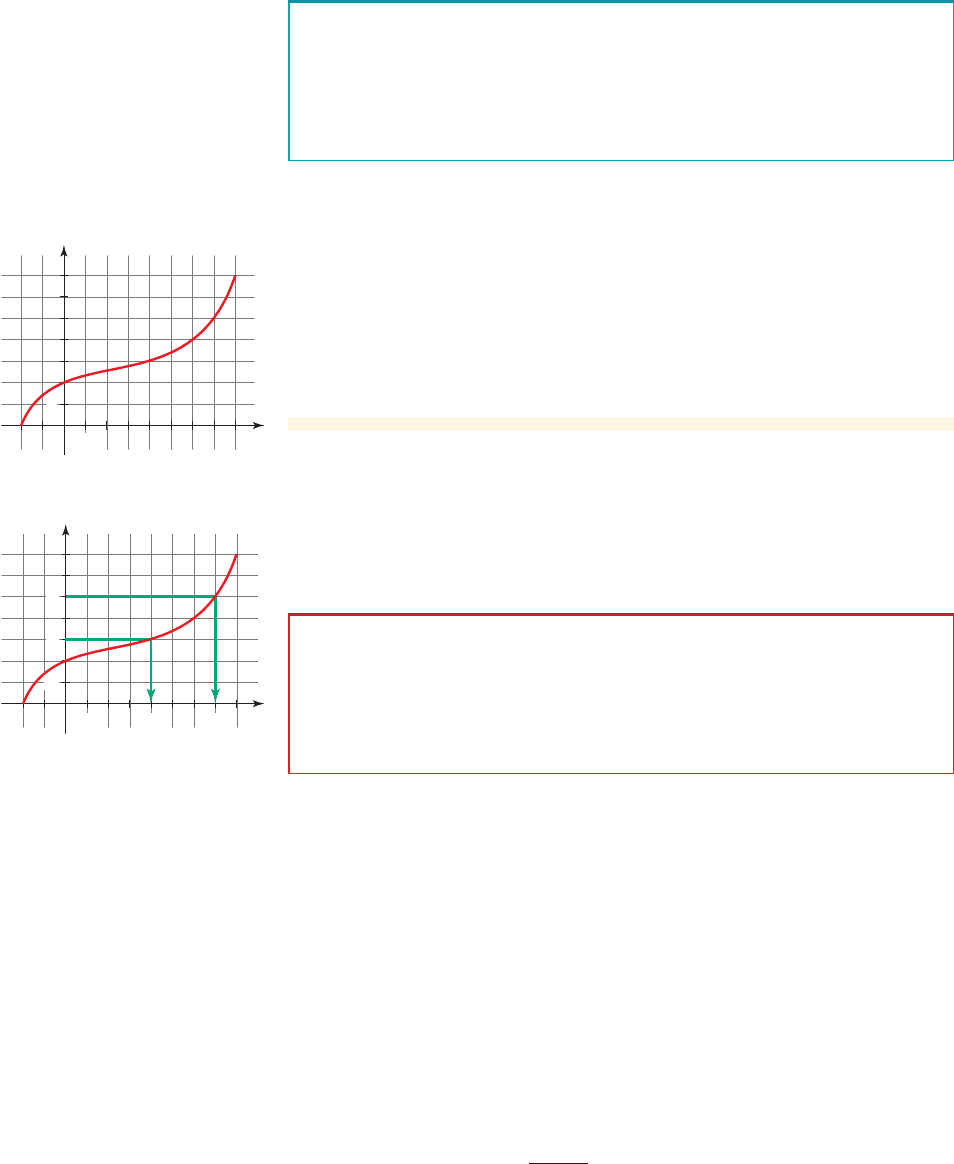
380 CHAPTER 4
■
Logarithmic Functions and Exponential Models
example
3
Finding the Values of f
⫺1
Graphically
The graph of a function f is given in Figure 3. Use the graph to find the following.
(a) (b)
Solution
(a) From the graph we see that , so . (See Figure 4.)
(b) From the graph we see that , so . (See Figure 4.)
■ NOW TRY EXERCISE 35 ■
Let’s see how we can find an equation for the inverse of a function f. From the def-
inition we see that if we can solve the equation for x, then we must have
. If we then interchange x and y, we get , which is the function
we want. Thus, we have the following procedure for finding the inverse of a function.
How to Find the Inverse of a Function
y = f
-1
1x 2x = f
-1
1y2
y = f 1x2
f
-1
15 2= 7f 17 2= 5
f
-1
132= 4f 142= 3
f
-1
152f
-1
13 2
x
0
1
1
f
y
figure 3 Graph of f
x
0
1
3
5
1 4 7
f
y
figure 4 Finding values of
from the graph of f
f
-1
In the next example we use these steps to find the inverse of the pizza function
P described earlier in this section.
To find the inverse of a function f:
Step 1 Write the function in equation form: .
Step 2 Solve this equation for x in terms of y (if possible).
Step 3 Interchange x and y. The resulting equation is .y = f
-1
1x 2
y = f 1x 2
Expressing a function in equation
form is studied in Section 1.5.
example
4
Finding the Inverse of a Function
Find the inverse of the function .
Solution
First we write P in equation form:
Then we solve this equation for x:
Equation
Subtract 12
Divide by 2 and switch sides
x =
y - 12
2
y - 12 = 2x
y = 2x + 12
y = 2x + 12
P1x 2= 2x + 12
If a function f has domain A and range B then its inverse function (if it
exists) is the function with domain B and range A defined by
for any y in B.
f
-1
1y 2= xif and only iff 1x2= y
f
-1
The Inverse of a Function

SECTION 4.6
■
Working with Functions: Composition and Inverse 381
In Example 4, notice how the rule
reverses the rule P: The func-
tion P is the rule “Multiply by 2,
then add 12.” The function is the
rule “Subtract 12, then divide by 2.”
P
-1
P
-1
example
5
Finding the Inverse of a Function
Find the inverse of the function .
Solution
First we write f in equation form:
Then we solve this equation for x:
Equation
Subtract 1
Divide by 2
Take the cube root and switch sides
Finally, we interchange x and y:
So the inverse function is .
■ NOW TRY EXERCISE 61 ■
It is not always possible to give a simple verbal description of the inverse of a
function. The next example shows why.
f
-1
1x2=
B
3
x - 1
2
y =
B
3
x - 1
2
x =
B
3
y - 1
2
y - 1
2
= x
3
y - 1 = 2x
3
y = 2x
3
+ 1
y = 2x
3
+ 1
f 1x2= 2x
3
+ 1
In Example 5, notice how the rule
reverses the rule f : The function
f is the rule “Cube x, multiply by 2,
then add 1.” The function is the
rule “Subtract 1, divide by 2, then
take the cube root.”
f
-1
f
-1
Finally, we interchange x and y:
So the inverse function is .
■ NOW TRY EXERCISE 57 ■
P
-1
1x 2=
x - 12
2
y =
x - 12
2
example
6
Finding the Inverse of a Function
Find the inverse of the function .
Solution
First we write f in equation form:
y =
3x
x + 2
f 1x2=
3x
x + 2

382 CHAPTER 4
■
Logarithmic Functions and Exponential Models
Let f be a function with domain A and range B. The function is the inverse
of f if and only if the following properties are satisfied:
for every x in A
for every x in B f 1g1x 22= x
g1f 1x 22= x
g
We can now use these properties to check whether two functions are inverses of
each other.
example
7
Checking That f and g Are Inverses of Each Other
Show that and are inverses of each other.
Solution
We need to check that and . We have
Definition of g
Definition of f
Simplify
Cancel 5
= x
=
5x
5
=
15x + 2 2- 2
5
f 1g1x 22= f 15x + 2 2
g1f 1x22= xf 1g1x22= x
g1x 2= 5x + 2f 1x 2=
x - 2
5
Then we solve this equation for x.
Equation
Multiply by
Distributive Property
Bring the x-terms to one side
Factor x
Divide by and switch sides
Finally, we interchange x and y:
So the inverse function is .
■ NOW TRY EXERCISE 63 ■
How can we check whether our answers to the preceding two examples are cor-
rect? By definition the inverse undoes what f does: If we start with x, apply f, and
then apply , we arrive back at x, where we started. Similarly, f undoes what
does. We can express these facts as follows.
Inverse Function Properties
f
-1
f
-1
f
-1
f
-1
1x2=
2x
3 - x
y =
2x
3 - x
3 - y x =
2y
3 - y
2 y = x13 - y2
2 y = 3x - yx
yx + 2y = 3x
x + 2 y1x + 22= 3x
y =
3x
x + 2
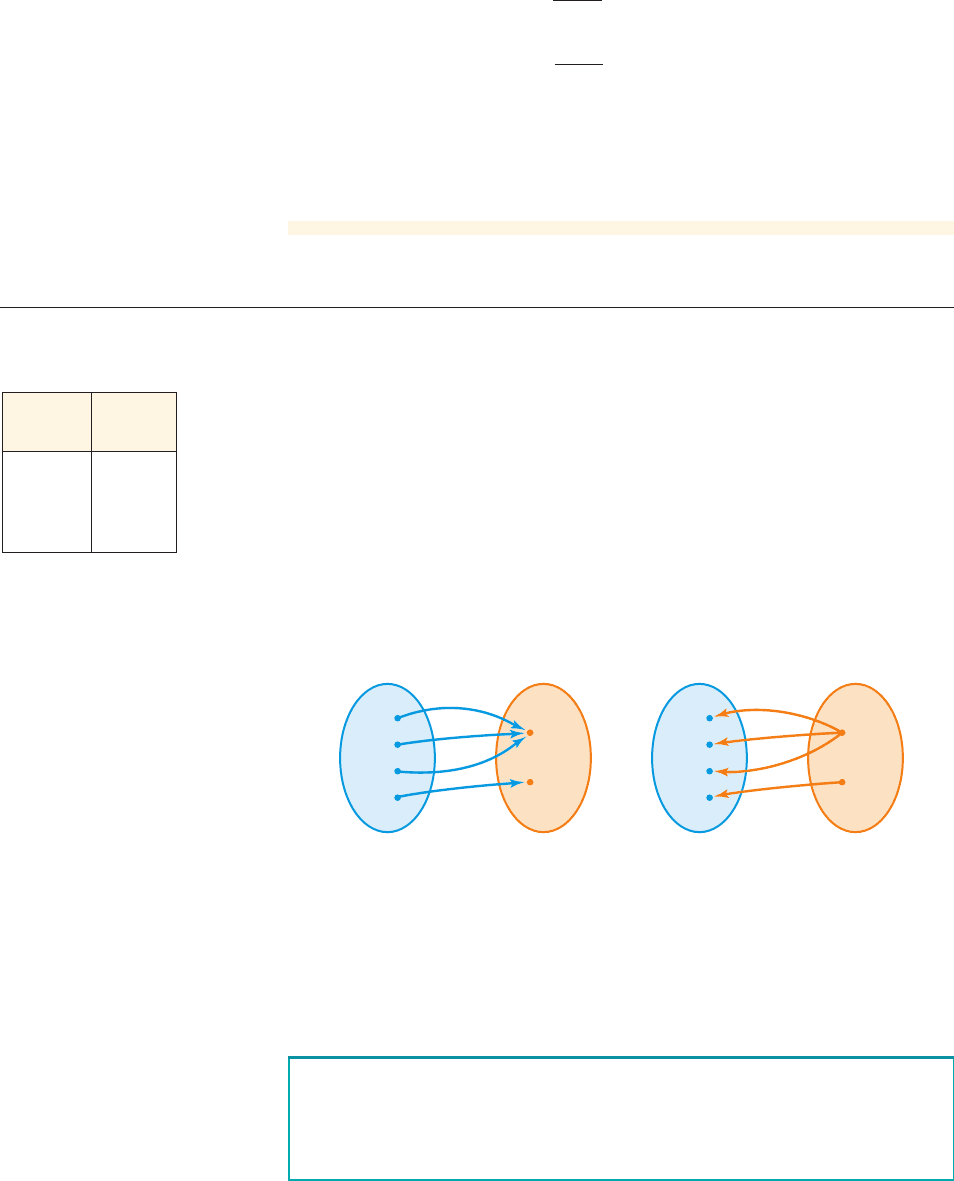
SECTION 4.6
■
Working with Functions: Composition and Inverse 383
2
■ Which Functions Have Inverses?
It’s not always possible to find the inverse of a function. For example, suppose your
local pizzeria has a coupon that gives you “up to two toppings for the same $12 price
as the plain cheese pizza—and $2 for each additional topping after that.” Table 2 gives
the price of a pizza for different numbers of toppings (if you use the coupon). So we
have a function P whose input is the number of toppings and whose output is the price.
If Jason tells you that he paid $12 for a pizza, you can’t tell how many toppings
the pizza had. Jason could have chosen to get one free topping, two free toppings, or
no free topping. The problem in finding an inverse of this function is that one output
corresponds to two (or more) different inputs. The diagram in Figure 5 illustrates the
situation. When we reverse the arrows, we get a relation that is not a function. So
there is no inverse function for this function.
table
2
Input:
toppings
Output:
price
0 12
1 12
2 12
3 14
Also
Definition of f
Definition of g
Cancel 5
Simplify
This shows that f and are inverses of each other.
■ NOW TRY EXERCISE 37 ■
g
= x
= 1x - 22+ 2
= 5 a
x - 2
5
b+ 2
g1f 1x22= ga
x - 2
5
b
0
1
2
3
$12
$14
Price
Function
Toppings
0
1
2
3
$12
$14
Price
Not a function
Toppings
figure 5
For a function to have an inverse, different inputs must correspond to different
outputs. (We can’t have two different inputs giving the same output.) Functions with
this property are called one-to-one, as in the following definition.
Definition of One-to-One Function
A function f is called one-to-one if no two different inputs have the same
output; that is,
if
x
1
⫽ x
2
thenf 1x
1
2⫽ f 1x
2
2
